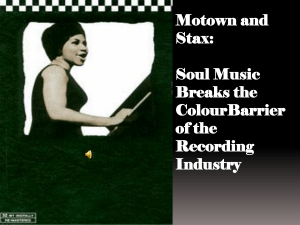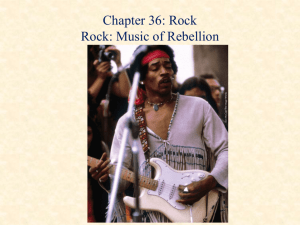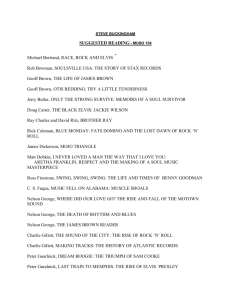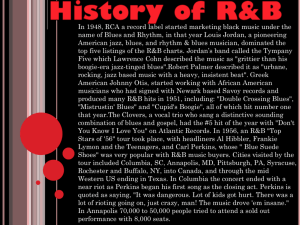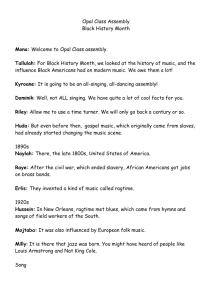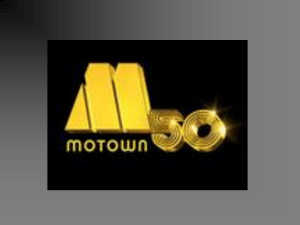Early Rock_Soul_442_students slides
advertisement
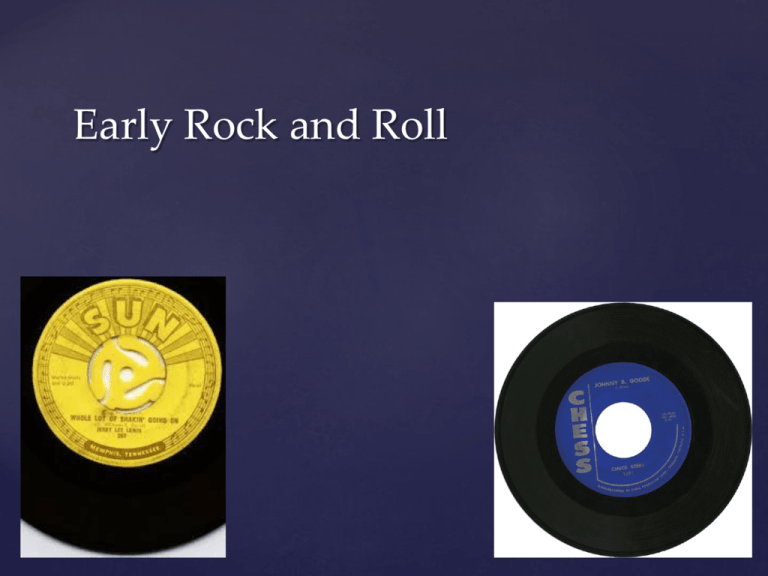
Early Rock and Roll
{
Rise of Youth Culture in the 1950s
What’s That Sound?:An Introduction to Rock and its History, 3rd Edition
Copyright © 2012 W. W. Norton & Company
Radio and Records
Rise of the disc jockey
The Moondog Show
Cleveland
Alan Freed
Red, Hot and Blue
Memphis
Dewey Phillips
The Rock and Roll Party
Crossover
Record or song appearing on more than one
chart
Rhythm and blues crossovers from 1954
Cover versions by white artists
Crossover and Covers
Fats Domino
Imperial Records (LA)
Established career in rhythm and
blues
Among the first rockers to
consistently cross over
Thirty-seven Top 40 singles,
1955–1963
Listening example: “Blueberry
Hill”
The First Rock and Rollers
Cross Over
Chuck Berry
Chess Records (Chicago)
Vocal delivery influenced by
country music
Songwriting style
Often targeted teens
Story songs
Lead guitar bursts were
influential
Example: “Johnny B. Goode”
The First Rock and Rollers
Cross Over
Little Richard
Specialty Records (LA)
First to adopt "wild man" persona
in rock and roll
Target for cover artists
Example: “Tutti Frutti”
The First Rock and Rollers
Cross Over
Whitening rhythm and
blues
Replacing references to
sexuality with references
to dancing
Bill Haley and the
Comets
Pat Boone
The First Rock and
Rollers Cross Over
Originally a country
band
“Rock Around the
Clock”
“Shake, Rattle and
Roll”
“Ain’t That a Shame”
“Tutti Frutti”
Sun Records (founded by
Sam Philips in 1952)
First demo, 1953
First proper session, July
1954
"That's All Right (Mama)"
“Blue Moon of Kentucky”
Elvis Presley
Rhythm and blues
lineage
Bluegrass lineage
RCA Records
Phillips takes $35K buyout
First single, early 1956
Television
“Heartbreak Hotel”
Three-way crossover hit
Ed Sullivan, Toast of the Town
Importance of major label involvement with
rock
Elvis Presley
Elvis’s material
Song selector, not writer
Rockabilly
Most without drums
Acoustic bass, acoustic guitar, electric guitar
Slapback echo
Elvis Presley
Broader appeal through RCA
U.S. Army, 1958–1960
Image makeover from 1960
Change to pop song-stylist
The Rise of Elvis Presley
Carl Perkins
Johnny Cash
Jerry Lee Lewis
Wanda Jackson
Brenda Lee
Buddy Holly
Rockabilly
Buddy Holly
Rockabilly
"That'll Be the Day,"
1957
Musical style
Motown Pop and Southern Soul
{
Pop hits by black artists in the late 1950s
Nat King Cole
Johnny Mathis
Gospel-influenced pop hits
Sam Cooke
“ A Change is Gonna Come”
Ray Charles
“Hit the Road Jack”
Sweet Soul
Drifters
“Sweet soul” style
Clyde McPhatter, featured singer
Ben E. King, featured singer
“There Goes My Baby”
Rhythm and blues
Orchestral strings
Ben E. King’s solo career
Dionne Warwick
Sweet Soul Artists
Greater opportunities for black artists to
have mainstream hits
Several regional centers
Detroit
Memphis
Muscle Shoals, AL
Atlanta
Black Pop between 1964 and
1970
Started by Berry Gordy
Motown, or "Hitsville U.S.A
Motown
Supremes
No hits until teamed with Holland, Dozier,
Holland
Long series of hit singles from 1964 to
1967
“Baby Love”
Martha and the Vandellas
Hits with Holland, Dozier, Holland
Clear gospel and rhythm-and-blues roots
Motown Artists and
Sound
Temptations
Initial hits written by Smokey Robinson
Listening Example: “The Way You Do the
Things You Do”
Then teamed with Norman Whitfield
Their “walk” choreography
Four Tops
Marvin Gaye
Stevie Wonder
Motown Artists
Southern take on black music
Very different than Motown
Much more heavily influenced by the blues and
gospel
Southern Soul
center of soul - Stax Records in Memphis
Named for founders - Jim Stewart and Estelle Axton
(founded 1958)
House band: Booker T. and the MGs
Integrated: Booker T. Jones (keyboard) and Al Jackson
(drums) black, Donald "Duck" Dunn (bass) and Steve Cropper
(guitar) white
Stax Records
Otis Redding
Gospel-influenced vocals
Driving accompaniment
Wilson Pickett
Signed to Atlantic
Recorded at Stax, 1965
Delayed backbeat
“In the Midnight Hour”
Recorded at Fame Studios (Muscle Shoals, AL)
Aretha Franklin
Listening Ex. “Respect”
Written by Otis Redding, who recorded it first
Isaac Hayes
“Shaft”
Stax artists
Doo-wop style records for King (Cinncinati)
Soul style
Tight, driving rhythm section
Aggressive singing
Famous for energetic, dance-filled stage
show
James Brown
Recorded album Live at the Apollo
Asserted extensive control over his music
“Papa’s Got a Brand New Bag, Pt. 1”
Led the move toward funk
James Brown
